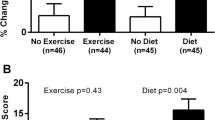Abstract
Purpose
Heart failure (HF) affects five million patients each year with both prevalence and incidence increasing with age. At least 20% of hospital admissions in patients > age 65 are due to HF. Cardiac resynchronization therapy (CRT) has been shown to improve HF symptoms and decrease mortality. However, little data are available which specifically address the effects of CRT in the elderly (>65).
Methods
We performed an analysis of the NYHA III/IV 839 patients randomized in the MIRACLE (n = 470) and MIRACLE-ICD (n = 369) trials. Both included patients with moderate to severe HF, ejection fraction (EF) ≤35%, and QRS duration ≥130 msec. Patients were grouped by age <65, 65–75, and >75 years. For each group, patients with CRT activated (ON) were compared with patients with CRT inactivated (OFF) for end points at 6 months, including New York Heart Association (NYHA) functional class and EF.
Results
Of the 839 patients, 368 were <65, 297 were 65–75, and 174 were >75 years old. Compared with controls, patients from all three age groups, whose CRT was activated, had statistically significant improvements in NYHA class (−0.84 for age <65, −0.78 for age 65–75, and −0.78 for age >75). All age groups with CRT ON also had statistically significant improvements in left ventricular EF (5.23%, 2.98%, and 4.03% respectively). There were no between group differences by age in LVEF improvement.
Conclusions
In elderly patients enrolled in the MIRACLE and MIRACLE-ICD trials, CRT resulted in significant improvements in NYHA class and LVEF, regardless of age. These data suggest that the full age range of patients with appropriate indications for implantation can benefit from CRT.
Similar content being viewed by others
References
Thomas, T., Haase, N., Rosamond, W., et al. (2006). Heart disease and stroke statistics—2006 update: a report from the AHA statistics committee and stroke statistics subcommittee. Circulation, 113, e85–e151.
Jessup, M., & Brozena, S. (2003). Heart failure. The New England Journal of Medicine, 348, 2007–2018.
Aranda Jr, J. A., Krause-Steinrauf, H. J., Greenberg, B. H., Keng, M. K., Kosolcharoen, P. K., Renlund, D. G., et al. (2002). Comparison of the beta blocker bucindolol in younger versus older patients with heart failure. The American Journal of Cardiology, 89, 1322–1326.
Cleland, J. G. F., Daubert, J. C., Erdmann, E., et al. (2005). The effect of cardiac resynchronization on morbidity and mortality in heart failure. The New England Journal of Medicine, 352, 1539–1549.
Lee, D. S., Tu, J. V., Austin, P. C., Dorian, P., Yee, R., Chong, A., et al. (2007). Effect of cardiac and noncardiac conditions on survival after defibrillator implantation. Journal of the American College of Cardiology, 49, 2408–2415.
Abraham, W. T., Fisher, W. G., Smith, A. L., et al. (2002). Cardiac resynchronization in chronic heart failure. The New England Journal of Medicine, 346, 1845–1853.
Young, J. B., Abraham, W. T., Smith, A. L., et al. (2003). Combined cardiac resynchronization and implantable cardioversion defibrillation in advanced heart failure. The MIRACLE ICD trial. Journal of the American Medical Association, 289, 2685–2694.
Bristow, M. R., Saxon, L. A., Boehmer, J., Krueger, S., Kass, D. A., De Marco, T., Comparison of Medical Therapy, Pacing, and Defibrillation in Heart Failure (COMPANION) Investigators, et al. (2004). Cardiac-resynchronization therapy with or without an implantable defibrillator in advanced chronic heart failure. The New England Journal of Medicine, 350, 2140–2150.
Bleeker, G. B., Schalij, M. J., Molhoek, S. G., et al. (2005). Comparison of effectiveness of cardiac resynchronization therapy in patients (70 versus ≥70 years of age). The American Journal of Cardiology, 96, 420–422.
Delnoy, P. P., Ottervanger, J. P., Luttikhuis, H. O., Elvan, A., Misier, A. R., Beukema, W. P., et al. (2008). Clinical response of cardiac resynchronization therapy in the elderly. American Heart Journal, 155, 746–751.
Sears, S. F., & Conti, J. B. (2003). Understanding ICD shocks and storms: Medical and psychosocial considerations for research and clinical care. Clinical Cardiology, 26, 107–111.
Achilli, A., Turreni, F., Gasparini, M., Lunati, M., Sassara, M., Santini, M., et al. (2007). Efficacy of cardiac resynchronization therapy in very old patients: the Insync/Insync ICD Italian Registry. Europace, 9, 732–738.
Healey, J. A., Hallstrom, A. P., Kuck, K.-H., Nair, G., Schron, E. P., Roberts, R. S., et al. (2007). Role of the implantable defibrillator among elderly patients with a history of life-threatening ventricular arrhythmias. European Heart Journal, 28, 1746–1749.
Reynolds, M. R., Cohen, D. J., Kugelmass, A. D., Brown, P. P., Becker, E. R., Culler, S. D., et al. (2006). The frequency and incremental cost of major complications among medicare beneficiaries receiving implantable cardioverter-defibrillators. Journal of the American College of Cardiology, 47, 2493–2497.
Acknowledgement
We would like to acknowledge Medtronic for allowing us to use data from the MIRACLE and MIRACLE-ICD trials and for assisting us with statistical analysis.
Author information
Authors and Affiliations
Corresponding author
Rights and permissions
About this article
Cite this article
Kron, J., Aranda, J.M., Miles, W.M. et al. Benefit of cardiac resynchronization in elderly patients: results from the Multicenter InSync Randomized Clinical Evaluation (MIRACLE) and Multicenter InSync ICD Randomized Clinical Evaluation (MIRACLE-ICD) trials. J Interv Card Electrophysiol 25, 91–96 (2009). https://doi.org/10.1007/s10840-008-9330-2
Received:
Accepted:
Published:
Issue Date:
DOI: https://doi.org/10.1007/s10840-008-9330-2




